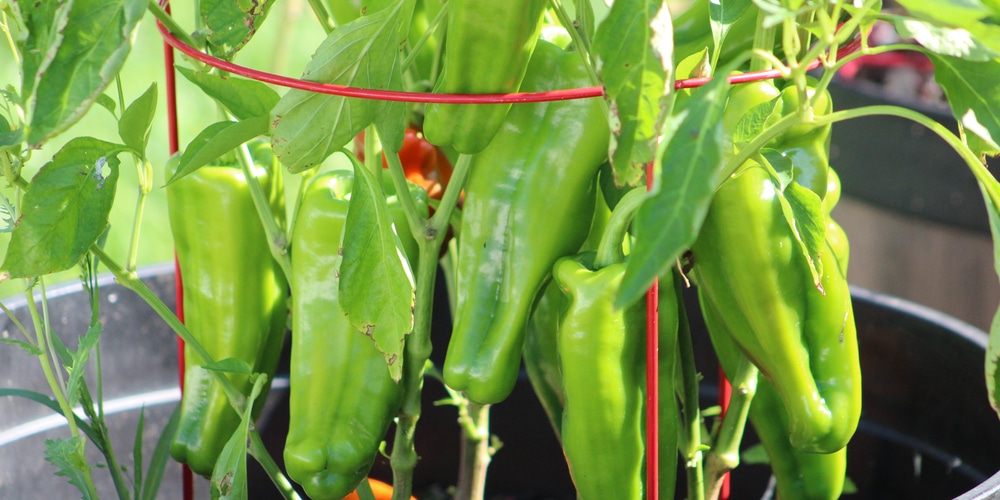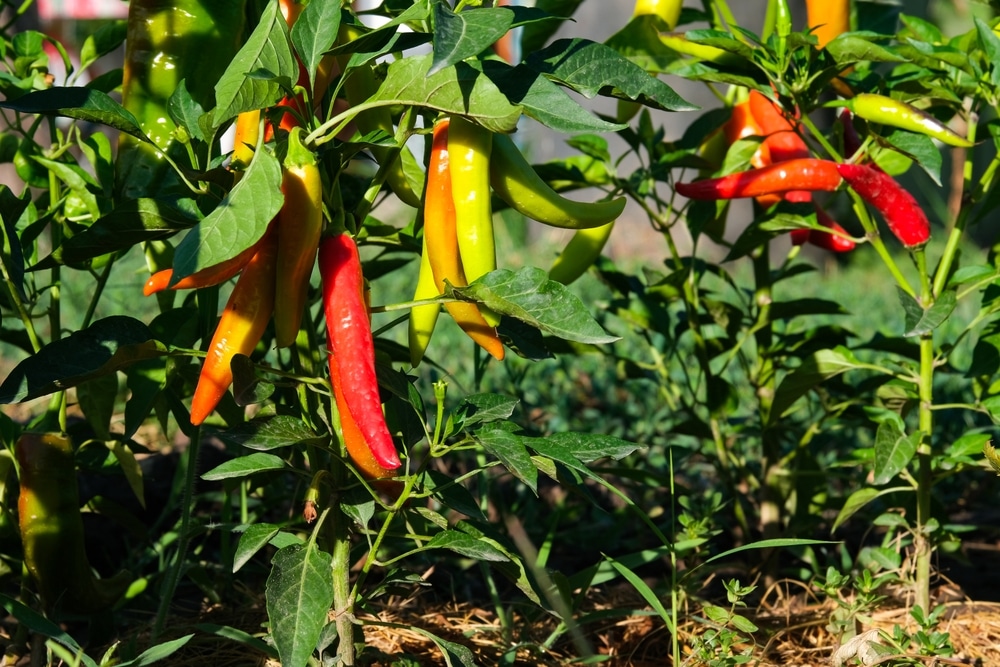| Question | When is the best time to plant peppers? |
|---|---|
| Answer | After the last frost in spring |
| More Info | Peppers need warm soil and temperatures to thrive. Plant them outdoors after the last spring frost when soil temperatures reach at least 60°F (15°C). In cooler climates, starting seeds indoors 6-8 weeks before the last frost date is recommended. For warmer regions, peppers can also be planted throughout the summer fo |
Understanding the Pepper Growth Cycle

To successfully cultivate peppers, gardeners should be well-versed in the growth cycle, starting with the germination process and extending through the development phases of the pepper plant.
Germination Essentials
The first critical step in the pepper plant’s life is germination, a process reliant upon specific conditions to ensure success.
High-quality seeds should be planted in a seed tray with well-draining soil, kept warm (ideally between 65-95°F or 18-35°C), and uniformly moist to trigger germination.
The presence of adequate warmth and moisture cues the seeds to break dormancy, hence why pepper seeds typically require about 7-14 days to sprout.
Phases of Pepper Plant Development
- Seedling Stage (0-4 weeks):
- The newly sprouted pepper forms its first leaves.
- Seedlings prefer about 16 hours of light daily.
- Vegetative Stage (5-10 weeks):
- Plants grow rapidly, developing a strong stem and more leaves.
- Transplanting to larger pots may be necessary to accommodate growth.
- Flowering and Pollination:
- Pepper plants begin to flower and require pollination to set fruit.
- Effects of inadequate pollination: fewer peppers.
- Fruit Set and Ripening:
- After successful pollination, peppers start to form and mature.
- Fruits first appear green and grow to full size before changing color.
The Right Time to Plant Peppers
Selecting the optimal planting time for peppers is essential for a successful harvest. This involves understanding your local climate conditions and ensuring soil temperatures are suitable for pepper seed germination and growth.
Climate Considerations
Gardeners must consider their Hardiness Zone and the average last frost date in their area when scheduling when to plant pepper seeds.
Peppers thrive in warm conditions and should be planted after the danger of frost has passed. Seedlings should only be transplanted outdoors once nighttime temperatures consistently remain above 55°F (13°C).
- Hardiness Zone 3: Last Frost Date: June 3-13; Plant Indoor Seeds: April 22 – May 2
- Hardiness Zone 4-7: Generally, 8-10 weeks before the last expected frost.
- Hardiness Zone 8+: May have a wider planting window due to milder winters.
Soil Temperature Requirements
Pepper seeds require warm soil to germinate effectively. The soil temperature should be at least 70°F (21°C) for optimal germination.
It’s recommended to use a soil thermometer to check the temperature at planting depth.
Below are the soil temperature guidelines for planting peppers:
- Sweet Peppers: Prefer soil temperatures between 70°F and 85°F (21°C and 29°C).
- Hot Peppers: May require soil temperatures at the higher end of this range for best germination rates.
Using heating mats can help maintain the soil temperature in cooler climates or during unexpected cold spells.
Preparing the Soil for Pepper Plants
To cultivate robust and healthy pepper plants, gardeners must focus on creating an ideal soil environment by targeting the soil composition and ensuring balanced fertilization tailored to the needs of pepper plants.
Soil Composition and Amendments
The foundation of success for pepper plants in the garden begins with the soil composition.
Peppers flourish in a sandy loam soil, which is characterized by a mixture of sand, silt, and a small amount of clay. This structure facilitates proper drainage while retaining adequate moisture for the roots.
Amending the soil with organic matter approximately 3-5%, like compost, enhances its fertility and structure.
To optimize the soil for pepper plants, one should:
- Test the soil pH: Peppers prefer a neutral to slightly acidic pH (6.0-6.8).
- Incorporate amendments:
- Add composted materials to increase organic content.
- Use sand or perlite to improve drainage in dense soils.
Proper Fertilization
Selecting the right fertilizer for pepper plants is crucial.
A balanced N-P-K ratio (Nitrogen, Phosphorous, Potassium) supports overall plant health and yield. However, it’s important not to overdo nitrogen-rich fertilizers, which can lead to lush foliage at the expense of fruit production.
Here is a guideline for fertilizing pepper plants:
- Before Planting: Work 5-10-10 fertilizer into the soil to prepare the bed.
- During the Growing Season: Use a balanced 10-10-10 fertilizer sparingly, or apply compost to deliver nutrients slowly.
Planting Techniques for Optimal Growth
Adequate spacing and proper depth during planting can drastically affect the health and yields of pepper plants. Gardeners should apply these critical techniques to foster robust growth and a plentiful harvest.
Seed Sowing Depth and Spacing
When sowing pepper seeds, ensure they are planted 1/4 to 1/2 inch deep in the soil. The seeds need to be spaced out to prevent overcrowding, which can impede their growth.
An optimal setup for seed starting would follow these guidelines:
- Spacing: Place seeds approximately 2 inches apart.
- Rows: Maintain between 24-36 inches between rows to allow for ample growth space and air circulation.
Once seeds have sprouted and seedlings have grown a few inches tall with true leaves, thin them to prevent competition, leaving the strongest plants to grow to maturity.
Transplanting Young Pepper Plants
Transplanting occurs after the seedlings have grown strong enough indoors and the outside temperature is suitable for pepper growth. Follow these steps for successful transplanting:
- Preparation: Amend the garden bed soil with compost to improve structure and fertility.
- Timing: Wait until after the last frost date to move seedlings outdoors.
- Plant spacing: Transplant pepper plants to the garden with 18-24 inches apart and rows spaced 24-36 inches apart.
- Soil health: Prior to transplanting, enrich the soil with balanced, slow-release granular fertilizer.
Post-Planting Care and Maintenance
Once peppers are planted, consistent attention to watering and pest control sets the stage for a bountiful harvest.
Watering Regimen
Proper watering is crucial for the development of healthy pepper plants.
They require a consistent supply of moisture, especially during dry spells. The goal is to maintain evenly moist soil without waterlogging.
Use the following guidelines:
- Seedlings: Provide enough water to keep the soil moist, but not soggy. Typically, this means watering when the top inch of soil feels dry.
- Mature Plants: As they grow, pepper plants need about 1-2 inches of water per week.
Pest and Disease Management
Pepper plants may encounter various pests and diseases throughout the growing season.
Vigilance and proactive measures are key to managing these issues effectively.
- Aphids: These tiny pests can be controlled with a strong spray of water or the application of insecticidal soap.
- Cutworms: Protect young seedlings with collars placed around the stem at soil level.
Disease Prevention:
- Fungal Diseases:
- Promote good air circulation by spacing plants properly and pruning when necessary.
- Apply fungicides early if problems are anticipated.
- Viral Diseases:
- Remove and destroy infected plants promptly to prevent spread.
By implementing a structured watering regimen and actively managing pests and diseases, growers can ensure their pepper plants thrive and produce an abundant crop.
Frequently Asked Questions
In their journey to spice up their gardens with vibrant peppers, gardeners often have important questions regarding the growth timeline and cultivation practices of these plants.
How long does it take to grow peppers from seed?
Growing peppers from seeds typically takes between 70 and 85 days before they start fruiting.
However, the exact time can vary based on the pepper variety. Some hot peppers like the Carolina Reaper take up to 150 days to ripen.
What are the stages of bell pepper ripening?
Bell peppers go through several stages of ripening: from green to either yellow, orange, or red, depending on the variety.
Initially, they begin as green peppers, regardless of their final ripened color. As they mature, the colors deepen, signaling increased sweetness and vitamin content.
What is the best month to plant green peppers?
Green peppers are best planted in the ground 2-3 weeks after the last frost when the soil has warmed adequately.
Depending on the local climate, this can vary; for many regions, this tends to be late spring or early summer.
When should pepper seedlings be transplanted outdoors?
Pepper seedlings should be transplanted outdoors once the threat of frost has passed and nighttime temperatures consistently stay above 55°F (13°C).
This ensures the tender plants are not damaged by cold.
When to start pepper seeds indoors for zone 6?
In zone 6, pepper seeds should be started indoors approximately 8-10 weeks before the last expected frost date.
This is typically around mid-February to early March, ensuring that the seedlings are ready to be transplanted outdoors in late spring.
How to identify if bell peppers are no longer good?
Bell peppers that are no longer good for consumption may exhibit wrinkles, soft spots, and an overall dull color.
Rotting or a foul odor is a clear indication that the peppers should be discarded.

